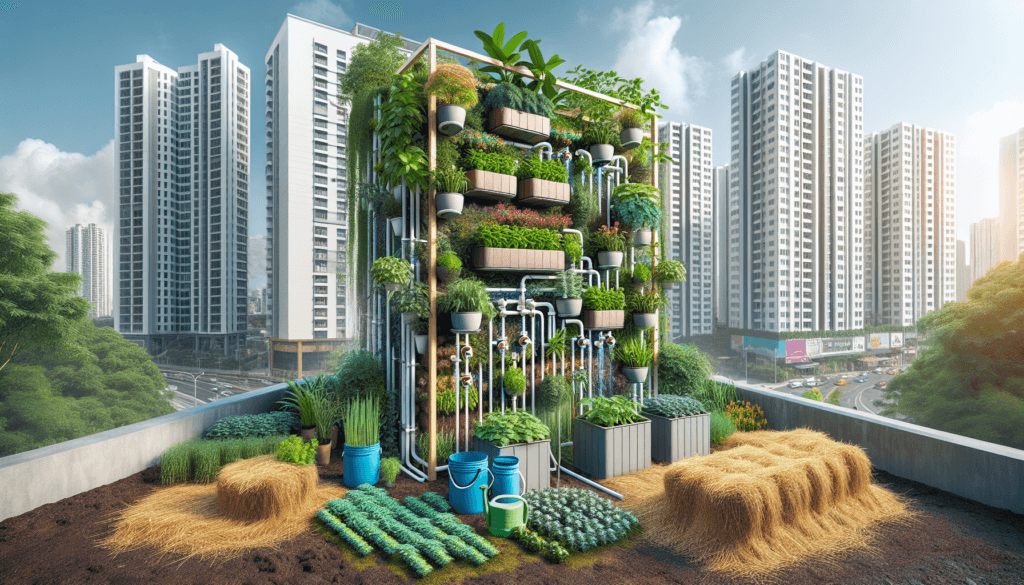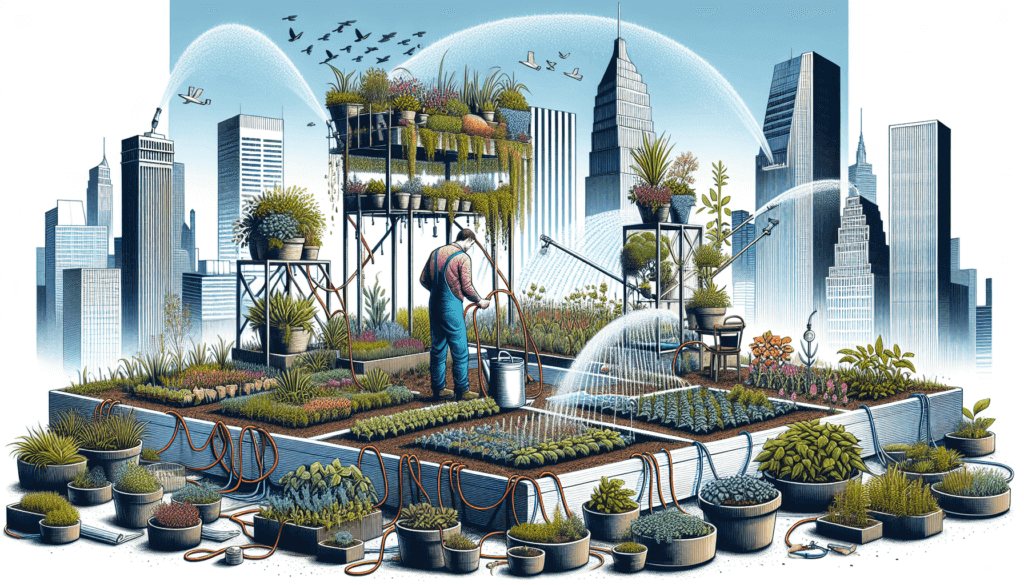Are you struggling to keep your urban garden thriving? Well, fret no more! In this article, you will discover the top tips for watering your urban garden efficiently. From understanding the watering needs of different plants to implementing smart watering techniques, we’ve got you covered. Say goodbye to wilted plants and hello to a lush, vibrant garden with these helpful tips. So, let’s get started and turn your urban oasis into a green paradise!

Choose the Right Plants for Your Urban Garden
When it comes to creating a thriving urban garden, it’s important to choose plants that are well-suited for the specific conditions of your environment. Consider the climate of your area and select plants that are known to thrive in those conditions. This will ensure that your garden not only survives but flourishes.
Consider the climate
Different plants have different climate preferences, so it’s important to take into account the specific conditions of your area. If you live in a hot and dry climate, choose plants that are drought-tolerant and can withstand high temperatures. On the other hand, if you live in a cooler and more humid environment, opt for plants that thrive in those conditions. By selecting plants that are well-adapted to your climate, you’ll be setting yourself up for gardening success.
Select drought-tolerant plants
In urban environments, water scarcity and restrictions are common. Therefore, it’s a good idea to choose plants that are drought-tolerant. These plants have adapted to survive with minimal water, making them ideal choices for water-efficient gardening. Succulents, Mediterranean herbs, and native grasses are some examples of drought-tolerant plants that are well-suited for urban gardens.
Choose native plants
Native plants are well-suited for the local climate and soil conditions, making them a perfect choice for urban gardening. These plants have evolved to survive in your area, so they will require less maintenance and watering. Additionally, native plants are beneficial to local wildlife, providing food and habitat for birds, bees, and butterflies. By choosing native plants, you’ll not only conserve water but also support the local ecosystem.
Opt for container gardening
If you have limited space in your urban garden or want the flexibility to move your plants around, container gardening is a great option. By planting in containers, you can control the soil moisture more efficiently, as containers tend to retain water better than garden beds. This can be especially useful in urban areas where the soil may be poor or compacted. Container gardening also allows you to elevate your plants, making them more accessible and adding visual interest to your space.
Understand Your Soil and Its Water Holding Capacity
Knowing the characteristics of your soil is essential for efficient watering. By understanding the water holding capacity of your soil and making appropriate amendments, you can ensure that your plants receive the right amount of water.
Test your soil
Before planting, it’s recommended to test your soil. Soil testing kits are readily available and can provide valuable information about the pH level, nutrient content, and water holding capacity of your soil. This information will help you determine the specific needs of your plants and guide your watering practices.
Amend the soil
If your soil has poor water holding capacity or drainage issues, it may be necessary to amend it. Adding organic matter such as compost or well-rotted manure can improve soil structure, increase the water holding capacity, and promote better plant growth. Additionally, incorporating perlite or vermiculite into heavy clay soils can enhance drainage and prevent waterlogging.
Add organic matter
Organic matter plays a crucial role in retaining moisture in the soil. By adding compost, leaf litter, or mulch to your garden, you can increase the water holding capacity of the soil. Organic matter acts like a sponge, absorbing and releasing water as needed, ensuring that your plants have access to a consistent water supply. Furthermore, it helps improve soil fertility and creates a favorable environment for beneficial soil organisms.
Improve water retention
To further improve water retention in your soil, consider using water-absorbing crystals or hydrogels. These products can be mixed into the soil or added to the planting hole, where they will absorb and release water to the roots of your plants. This can be particularly beneficial in areas prone to drought or if you have plants with high water requirements.
Water in the Morning
Choosing the right time of day to water your plants is crucial for optimizing water usage and promoting healthy growth. Watering in the morning offers several advantages over other times of the day, making it the ideal choice for efficient irrigation.
Take advantage of cooler temperatures
Watering in the morning allows you to take advantage of cooler temperatures. During the early hours of the day, the temperature is typically lower, which means there is less evaporation compared to watering in the heat of the day. By avoiding midday sun and high temperatures, you can ensure that your plants receive the maximum benefit from the water you provide.
Reduce evaporation
Watering in the morning also helps to reduce evaporation. As the day progresses and temperatures rise, water droplets on the leaves and soil surface will evaporate more quickly. By watering early, you give the water ample time to soak into the soil and reach the plant’s roots before evaporation becomes a concern. This ensures that your plants receive the maximum amount of water they need to thrive.
Promote deep root growth
Watering in the morning promotes deep root growth, which leads to healthier and more drought-tolerant plants. When you water in the morning, the moisture has a chance to penetrate deeply into the soil, encouraging the roots to grow downward in search of water. This helps the plant establish a strong root system that can access deeper water reserves, making it more resilient during periods of water scarcity.
Prevent fungal and pest problems
Watering in the morning helps to prevent fungal and pest problems in your garden. By giving your plants time to dry out before the evening, you reduce the risk of foliage and soil moisture becoming a breeding ground for pests and diseases. Additionally, watering in the morning allows the leaves to dry quickly, minimizing the chances of fungal infections that thrive in damp conditions.
Use the Right Watering Techniques
Watering your urban garden properly involves more than just the timing. Using the right techniques will ensure that water is applied efficiently and reaches the plants’ roots where it’s most needed.
Water at the base of the plants
When watering your plants, it’s important to target the base of the plant rather than spraying the entire foliage. Directing the water to the roots ensures that it reaches the areas where the plant can absorb it most effectively. Avoiding unnecessary contact with the leaves also helps prevent the spread of diseases and minimizes water loss through evaporation.
Avoid overhead watering
Overhead watering, such as using a sprinkler or a watering can with a broad spout, can waste a significant amount of water through evaporation and runoff. Additionally, it can lead to the development of fungal diseases by keeping the foliage wet for extended periods. Whenever possible, opt for targeted watering methods that deliver water precisely where it’s needed, minimizing waste and promoting efficient plant hydration.
Use drip irrigation
Drip irrigation is a highly efficient watering technique that delivers water directly to the plant’s root zone. It involves placing hoses or tubes with small holes or emitters near the base of the plants, allowing the water to slowly seep into the soil. Drip irrigation reduces water loss through evaporation and eliminates runoff, as the water is applied directly to the plant’s roots. This method also helps keep the foliage dry, minimizing the risk of fungal diseases.
Mulch your garden beds
Mulching is an effective technique for conserving water in your garden. By applying a layer of organic mulch, such as wood chips or straw, around your plants, you can reduce water evaporation from the soil surface. Mulch acts as a protective barrier, shielding the soil from direct sunlight and wind, which can dry it out quickly. Additionally, mulch helps regulate soil temperature, suppresses weed growth, and improves overall soil health.

Use Watering Tools Wisely
The choice of watering tools can greatly impact the efficiency of your watering practices. By selecting the right tools and using them correctly, you can conserve water and ensure that your plants receive adequate hydration.
Choose a watering can with a narrow spout
When using a watering can, opt for one with a narrow spout. This allows you to direct the water precisely to the base of the plants, ensuring minimal water waste. A narrow spout helps you avoid splashing water on the leaves and surrounding soil and promotes targeted watering for maximum efficiency.
Use a hose with a nozzle
If you prefer using a hose for watering, make sure to attach a nozzle to it. Nozzles provide greater control over the water flow, allowing you to adjust the pressure and pattern of the spray. By using a nozzle, you can easily direct the water at the base of the plants and avoid wasting water on areas that don’t need it.
Consider a soaker hose
A soaker hose is a fantastic tool for efficient watering, especially for garden beds or larger areas. These hoses are made with tiny pores or perforations that allow water to seep out slowly and directly into the soil. By placing the soaker hose along the base of your plants, you can ensure that water is delivered efficiently and evenly, reducing waste and promoting deep root growth.
Invest in a water-saving irrigation system
For larger urban gardens or those with complex irrigation needs, investing in a water-saving irrigation system can provide significant benefits. These systems can be programmed to water at specific times and in specific amounts, ensuring optimal efficiency. Drip irrigation systems, sprinklers with moisture sensors, and smart irrigation controllers are some examples of water-saving options that can help you conserve water and maintain a healthy garden.
Implement Water-Saving Strategies
To further enhance the efficiency of your watering practices, consider implementing water-saving strategies that align with your urban gardening goals. These strategies can help you maximize water usage while minimizing waste.
Collect rainwater
One of the easiest and most environmentally friendly ways to conserve water is by collecting rainwater. Set up rain barrels or cisterns to capture rainwater from your roof or downspouts. This stored water can then be used to irrigate your garden during dry periods, reducing your reliance on municipal water supplies.
Install a water reservoir
Installing a water reservoir in your garden can provide a readily available water source for your plants. These reservoirs can be in-ground or above-ground structures, designed to collect and store water for later use. By using gravity or manual pumping, you can distribute this water directly to your plants, reducing the need for additional watering from external sources.
Implement a water-efficient design
To make the most of your water resources, consider designing your urban garden in a water-efficient manner. Group plants with similar watering needs together, so you can tailor your watering practices to specific areas rather than wasting water on plants with different requirements. Additionally, include features such as swales, terraces, or mulch basins to capture and retain water in the landscape, maximizing its availability to your plants.
Group plants with similar watering needs
When designing your urban garden, grouping plants with similar watering needs can significantly improve water efficiency. By placing plants with high water requirements together and those with low water needs in a separate area, you can direct your watering efforts more effectively. This prevents overwatering or underwatering certain plants and ensures that each group receives the appropriate amount of water for optimal growth.

Monitor Soil Moisture Levels
Monitoring the moisture levels of your soil is essential to prevent overwatering or underwatering your plants. By using simple tools and observation techniques, you can ensure that your plants receive the right amount of water at the right time.
Use a moisture meter
A moisture meter is a handy tool that allows you to measure the moisture content of your soil. By inserting the probe into the soil, you can get an accurate reading of how moist or dry it is. This helps you determine if your plants need watering and prevents over or underwatering. Moisture meters are available at most garden centers and are a worthwhile investment for any urban gardener.
Learn to read the signs of water stress
In addition to using a moisture meter, it’s important to learn how to read the signs of water stress in your plants. Wilting, yellowing leaves, and stunted growth are common indicators that your plants are not receiving enough water. On the other hand, leaf discoloration, root rot, and mold growth may indicate overwatering. By closely observing your plants and understanding their specific needs, you can adjust your watering practices accordingly.
Avoid overwatering
Overwatering is a common mistake that can lead to plant stress and even death. To avoid overwatering, make sure to check the moisture levels of your soil before watering. If the soil is still moist an inch or two below the surface, it’s likely that your plants don’t need water yet. Overwatering can not only waste water but also deprive plants of oxygen, leading to root rot and other issues.
Adjust watering frequency based on weather conditions
It’s important to adjust your watering frequency based on the weather conditions in your area. During periods of heavy rainfall or high humidity, you may need to water less frequently, as the soil will already be moist. Conversely, during hot and dry spells, you may need to increase the frequency of watering to ensure that your plants receive adequate hydration. By staying attuned to the weather, you can avoid under or overwatering and keep your plants healthy.
Consider Watering Frequency
Establishing a consistent watering schedule can help your plants thrive while conserving water. By understanding the specific needs of your plants and adjusting your watering habits accordingly, you can maintain healthy growth and minimize water waste.
Establish a watering schedule
Having a watering schedule can keep you organized and ensure that your plants receive consistent moisture. Consider the specific requirements of each plant in your garden and create a watering calendar based on their needs. Some plants may require more frequent watering, while others can withstand drier conditions. By establishing a routine, you can prevent under or overwatering and support optimal plant health.
Water more deeply and less frequently
When watering your plants, it’s generally more effective to water deeply and less frequently. This encourages the roots to grow deeper into the soil in search of water, promoting healthier and more resilient plants. Shallow watering, on the other hand, can lead to shallow root growth, making plants more susceptible to drought stress. By providing a thorough and deep watering, you can reduce water waste and maximize the benefits for your plants.
Learn the specific needs of your plants
Every plant has unique watering requirements, so it’s important to familiarize yourself with the needs of each species in your garden. Some plants, such as ferns or hydrangeas, prefer consistently moist soil, while others, like succulents or cacti, thrive in drier conditions. By understanding the specific needs of your plants, you can tailor your watering practices to ensure optimal growth and conserve water.
Adjust watering during different growth stages
Plants have different water requirements at various growth stages. For example, young seedlings and transplants may need more frequent watering to establish strong root systems. Once established, they may require less water. Flowering and fruiting plants often have higher water needs during their peak growth and production periods. By adjusting your watering frequency based on the growth stage of your plants, you can provide them with the ideal conditions for development while minimizing water waste.

Practice Water Conservation
In an urban environment, water conservation is of utmost importance. By adopting water-saving practices and being mindful of your water usage, you can make a significant difference in conserving this precious resource.
Avoid watering during peak sun hours
Watering during the peak sun hours, typically between 10 am and 4 pm, can result in excessive water loss through evaporation. The water droplets can quickly evaporate before reaching the plant’s roots, leading to wasted water and inefficient watering. To conserve water, try to schedule your watering sessions for the early morning or late afternoon when temperatures are cooler, and evaporation rates are lower.
Reduce water runoff
Water runoff can lead to water wastage and can also carry away valuable soil and nutrients. To reduce runoff, make sure your garden beds are properly sloped to allow water to penetrate the soil rather than running off the surface. You can also use mulch or create retention walls to slow down water flow and promote absorption. By reducing water runoff, you can ensure that your plants receive the maximum benefit from each watering.
Reuse household water
Another effective way to conserve water in your urban garden is by reusing household water. This water, known as greywater, can come from activities such as dishwashing, laundry, or showering. Collect the water and use it to irrigate your plants, avoiding any contact with edible crops. Greywater systems and portable capturing devices can be installed to make the collection and reuse process easier. By reusing greywater, you can significantly reduce your reliance on freshwater sources for gardening.
Promote soil health
Healthy soil is essential for efficient water usage in your garden. By promoting soil health through practices such as composting, using organic matter, and reducing the use of chemical fertilizers, you can enhance its water-holding capacity. Healthy soil with good structure and organic content can better retain moisture, reducing the need for frequent watering. It also supports beneficial soil organisms that contribute to soil fertility and overall plant health.
Monitor and Maintain Your Irrigation System
To ensure optimal watering efficiency, it’s important to regularly monitor and maintain your irrigation system. By keeping your system in good working order, you can prevent water waste, address any issues promptly, and promote healthy plant growth.
Inspect for leaks and blockages
Regularly inspect your irrigation system for leaks, blockages, or other malfunctions. Check the hoses, pipes, and connections for any signs of damage or wear. Leaks can waste a significant amount of water and result in uneven watering, while blockages can restrict water flow and cause uneven distribution. By addressing these issues promptly, you can minimize water waste and ensure that your plants receive the proper amount of water.
Ensure proper sprinkler alignment
If you use sprinklers as part of your irrigation system, it’s important to ensure proper alignment. Misaligned sprinkler heads can lead to overspray, wasting water on non-essential areas such as walkways or driveways. Adjust the direction and angle of the sprinkler heads to ensure that the water is being delivered precisely where it’s needed. This will help you conserve water and promote efficient plant hydration.
Clean and unclog irrigation components
Over time, irrigation components such as sprinkler heads, emitters, or nozzles can become clogged with debris or mineral buildup. Clean and unclog these components regularly to ensure proper water flow and prevent uneven watering. Remove any obstructions and rinse the components thoroughly to maintain optimal irrigation performance.
Calibrate watering timers
If you use irrigation timers or controllers, periodically calibrate them to ensure accurate watering. Check the settings to make sure they align with the specific needs of your plants and the weather conditions in your area. Calibrating your watering timers enables you to water only as much as necessary, preventing both under and overwatering and promoting efficient water usage.
In conclusion, efficient watering practices are crucial for the success of your urban garden. By choosing the right plants, understanding your soil, and using the appropriate watering techniques and tools, you can create a thriving garden while conserving water. Implementing water-saving strategies, monitoring soil moisture levels, and practicing water conservation are additional steps you can take to maximize efficiency. By being mindful of your watering practices and maintaining your irrigation system, you can ensure that your urban garden thrives while minimizing water waste. With these tips and techniques, you’ll be well-equipped to enjoy a beautiful and sustainable urban garden.



